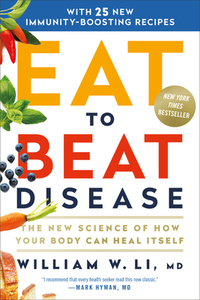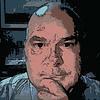Take a photo of a barcode or cover
The most helpful part of this book is the recommended system for including healthy foods into your diet. My discomfort comes from what I believe is an undue reliance on epidemiological nutrition studies. They have to be taken with more than a grain of salt, because at best, they only show a correlation, not causation (which is implied throughout the book). The 'new' science isn't that new. If you're interested in the book, I suggest skimming it for the recommended foods and reading the section about how to work them into your routine.
I was really excited about the concept, but the book was twice as long as necessary, extremely repetitive, and repeated typical talking points like "rah rah whole grains, soy is a health food, cholesterol is evil, saturated fat is evil" and even touts commercial fruit juices without any caveats whatsoever!
Overall, extremely biased with a few interesting tidbits--and these were so few and far between that I felt like I was reading 300 pages to get 1/10th of the story. Read Jonny Bowden instead: his books are truly unbiased and will get you the real facts behind why everything they say about cholesterol is a lie, why soy is toxic poison to be eaten sparingly and fermented only, and why whole grains aren't half of what they're cracked up to be!
Disappointing.
Overall, extremely biased with a few interesting tidbits--and these were so few and far between that I felt like I was reading 300 pages to get 1/10th of the story. Read Jonny Bowden instead: his books are truly unbiased and will get you the real facts behind why everything they say about cholesterol is a lie, why soy is toxic poison to be eaten sparingly and fermented only, and why whole grains aren't half of what they're cracked up to be!
Disappointing.
Good science, but the reader got on my nerves after awhile.
*I received this book for free through Goodreads Giveaways*
Take note of the subtitle "The New Science of How Your Body Can Heal Itself" because the book does not skimp on that part; it's not overly dry or academic but I found myself wanting to skip quite a bit to just get to the "what should I do" portions of the book, past all the nutritionist-speak. If you're looking more for a quick-easy-steps/action-how-to book, maybe look somewhere else. That having been said good info to have even if I'm not sure that the 5x5x5 method deployed here is truly necessary.
Take note of the subtitle "The New Science of How Your Body Can Heal Itself" because the book does not skimp on that part; it's not overly dry or academic but I found myself wanting to skip quite a bit to just get to the "what should I do" portions of the book, past all the nutritionist-speak. If you're looking more for a quick-easy-steps/action-how-to book, maybe look somewhere else. That having been said good info to have even if I'm not sure that the 5x5x5 method deployed here is truly necessary.
This book brought nothing new to the table. Maybe its because I read a lot of health books, but I knew pretty much everything that was talked about in this book. It left a bad taste in my mouth when he kept forcing his opinion of why you should eat soy. Literally, he was saying soy would cure everything, and I know that its not true.
This book was mostly just a list of foods that have been shown to keep you healthy - things we already know, like dark chocolate, olive oil, fish, etc.
I took the health exam in the back and scored a 2, which means 0-9 is optimal health, 9 and above is bad health. I guess that proves I've done my research and know how to keep myself healthy.
This book was mostly just a list of foods that have been shown to keep you healthy - things we already know, like dark chocolate, olive oil, fish, etc.
I took the health exam in the back and scored a 2, which means 0-9 is optimal health, 9 and above is bad health. I guess that proves I've done my research and know how to keep myself healthy.
There is a lot of information in this book. The good thing is that it was written so that I could understand it. There have been books on nutrition and it’s effects on disease and the body that we’re good but difficult to get through. I didn’t have that problem with this book. The author did a good job explaining things without forcing me to look up every other word. Considering the fact the first portion of this book will have you feeling like you are in school, I was very happy to see this.
I love the listing of what foods you can enjoy that are helping your body. The author doesn’t say here are five foods, eat them for health whether you like them or not. Instead we are told to go through the list so we can choose food we already love along with some that we may want to try. I really like this not only because I’m not the most adventurous in food, but because I live where finding everything might be challenging and then there is cost. Having the list and being able to just pick off the food you enjoy, can easily find and fits the food budget is as important as the knowledge about nutrition. The truth is that what we eat has a direct affect on our body and health. Food can harm or heal. To do either, though, the food has to be available and what we want to eat. I like the authors 5x5x5 Framework in the last part of the book. It should be noted that this isn’t for weight loss, (though I think healthier eating does help with that). This is an easy way to add disease fighting food to your diet. You pick 5 foods that you add to your diet and enjoy them 5 times a day. Your goal with them is to cover the 5 defense systems that you read about in the book. I love that I can choose to eat them together or eat them as part of meals and snacks. The last portion of the book is where you will find the lists, along with recipes to try, tips on incorporating the food to your menu, a sample menu to help guide you and a section on assessing your risk.
I recommend this book for people who are interested in healthy eating. I won an advanced copy of this book from Goodreads Giveaways. The final book may differ from my copy.
I love the listing of what foods you can enjoy that are helping your body. The author doesn’t say here are five foods, eat them for health whether you like them or not. Instead we are told to go through the list so we can choose food we already love along with some that we may want to try. I really like this not only because I’m not the most adventurous in food, but because I live where finding everything might be challenging and then there is cost. Having the list and being able to just pick off the food you enjoy, can easily find and fits the food budget is as important as the knowledge about nutrition. The truth is that what we eat has a direct affect on our body and health. Food can harm or heal. To do either, though, the food has to be available and what we want to eat. I like the authors 5x5x5 Framework in the last part of the book. It should be noted that this isn’t for weight loss, (though I think healthier eating does help with that). This is an easy way to add disease fighting food to your diet. You pick 5 foods that you add to your diet and enjoy them 5 times a day. Your goal with them is to cover the 5 defense systems that you read about in the book. I love that I can choose to eat them together or eat them as part of meals and snacks. The last portion of the book is where you will find the lists, along with recipes to try, tips on incorporating the food to your menu, a sample menu to help guide you and a section on assessing your risk.
I recommend this book for people who are interested in healthy eating. I won an advanced copy of this book from Goodreads Giveaways. The final book may differ from my copy.
As the Greek physician Hippocrates said, "Let food be thy medicine, and let medicine be thy food." Dr. William Li argues much the same, in a well-researched and well-written book about how foods can prevent and sometimes cure disease. All of Dr. Li's recommendations are backed by scientific studies. What is different about this book, than others, is how he introduces the body's five disease defense systems; then he goes through each system, and recounts the research that shows which foods are specifically helpful. Then he lists all of the foods that help each defense system.
The five disease defense systems are:
1) Angiogenesis; the process that forms blood vessels. It is a balancing act, as you need blood vessels to grow, especially in damaged areas. But too much blood vessel growth can contribute to cancer.
2) Regeneration; stem cells are needed to maintain, repair, and regenerate our bodies.
3) Microbiome; Bacteria in our bodies control the immune system, produce hormones, and influence angiogenesis.
4) DNA protection; defense against solar radiation, chemicals, stress, poor diet, and lack of sleep.
5) Immunity; Influenced by our guts, and helps to wipe out cancer.
Drugs can target specific diseases, but always come with potential side effects; drugs are never about balance. However, dietary factors lack destructive power. Foods can help keep the body's angiogenesis in balance. As an example, the book lists anti-angiogenic foods that help keep blood vessels from over-growing, thus helping to keep cancer in check: Broccoli, kale, fruits with pits, apples, berries, tea, red wine, tree nuts and beans, barley and seeds. Dr. Li writes that soy is also helpful. He writes that it is an urban legend that women should avoid soy. Studies show that soy helps protect against cancer, regardless of whether a woman's estrogen receptor is positive or negative. Tomatoes contain useful bioactives, and are better after cooking, which makes the lycopene easier to absorb.
Dr. Li also lists foods that can be harmful. Diets that impair the growth of stem cells include high-fat diets, high-salt diets, and high-sugar diets. On the other hand, cancer stem cells can be killed with green tea, purple potatoes, walnuts, and extra-virgin olive oil. Cancer stem cells can also be suppressed by bioactives found in celery, oregano, thyme, capers, apples, peppers, red wine, grapes, peanuts, pistachios, dark chocolate, and cranberries.
Dr. Li also describes how many fermented food help to increase the diversity of your gut microbiome. He argues that the guiding principles for keeping your gut microbiome healthy are: 1) dietary fiber from whole food, 2) less animal protein, 3) fresh whole foods, less processed foods. But I don't quite understand this; if less animal protein is good for you gut, then why eat any animal protein at all? In fact, he argues that seafood and Pacific oysters are helpful for triggering epigenetic changes that help repair damaged DNA.
The last portion of the book describes what Dr. Li calls a 5x5x5 framework for eating to beat disease. It is primarily a plant-based diet, but includes certain seafood, dark chicken meat, cheeses and yogurt. Hmmm... I am not quite in agreement here. I this this topic is better researched by Dr. Greger's [b:How Not to Die: Discover the Foods Scientifically Proven to Prevent and Reverse Disease|25663961|How Not to Die Discover the Foods Scientifically Proven to Prevent and Reverse Disease|Michael Greger|https://i.gr-assets.com/images/S/compressed.photo.goodreads.com/books/1436292289l/25663961._SY75_.jpg|45486853]. I think that Dr. Greger's approach to interpreting scientific research is better, as he looks at the research more critically and carefully.
Nevertheless, this is a good book that describes in some detail, the research that describes the link between foods and the disease defense mechanisms. He summarizes the research for each food-defense mechanism. So, if you like reading about this research, then this is the book for you.
The five disease defense systems are:
1) Angiogenesis; the process that forms blood vessels. It is a balancing act, as you need blood vessels to grow, especially in damaged areas. But too much blood vessel growth can contribute to cancer.
2) Regeneration; stem cells are needed to maintain, repair, and regenerate our bodies.
3) Microbiome; Bacteria in our bodies control the immune system, produce hormones, and influence angiogenesis.
4) DNA protection; defense against solar radiation, chemicals, stress, poor diet, and lack of sleep.
5) Immunity; Influenced by our guts, and helps to wipe out cancer.
Drugs can target specific diseases, but always come with potential side effects; drugs are never about balance. However, dietary factors lack destructive power. Foods can help keep the body's angiogenesis in balance. As an example, the book lists anti-angiogenic foods that help keep blood vessels from over-growing, thus helping to keep cancer in check: Broccoli, kale, fruits with pits, apples, berries, tea, red wine, tree nuts and beans, barley and seeds. Dr. Li writes that soy is also helpful. He writes that it is an urban legend that women should avoid soy. Studies show that soy helps protect against cancer, regardless of whether a woman's estrogen receptor is positive or negative. Tomatoes contain useful bioactives, and are better after cooking, which makes the lycopene easier to absorb.
Dr. Li also lists foods that can be harmful. Diets that impair the growth of stem cells include high-fat diets, high-salt diets, and high-sugar diets. On the other hand, cancer stem cells can be killed with green tea, purple potatoes, walnuts, and extra-virgin olive oil. Cancer stem cells can also be suppressed by bioactives found in celery, oregano, thyme, capers, apples, peppers, red wine, grapes, peanuts, pistachios, dark chocolate, and cranberries.
Dr. Li also describes how many fermented food help to increase the diversity of your gut microbiome. He argues that the guiding principles for keeping your gut microbiome healthy are: 1) dietary fiber from whole food, 2) less animal protein, 3) fresh whole foods, less processed foods. But I don't quite understand this; if less animal protein is good for you gut, then why eat any animal protein at all? In fact, he argues that seafood and Pacific oysters are helpful for triggering epigenetic changes that help repair damaged DNA.
The last portion of the book describes what Dr. Li calls a 5x5x5 framework for eating to beat disease. It is primarily a plant-based diet, but includes certain seafood, dark chicken meat, cheeses and yogurt. Hmmm... I am not quite in agreement here. I this this topic is better researched by Dr. Greger's [b:How Not to Die: Discover the Foods Scientifically Proven to Prevent and Reverse Disease|25663961|How Not to Die Discover the Foods Scientifically Proven to Prevent and Reverse Disease|Michael Greger|https://i.gr-assets.com/images/S/compressed.photo.goodreads.com/books/1436292289l/25663961._SY75_.jpg|45486853]. I think that Dr. Greger's approach to interpreting scientific research is better, as he looks at the research more critically and carefully.
Nevertheless, this is a good book that describes in some detail, the research that describes the link between foods and the disease defense mechanisms. He summarizes the research for each food-defense mechanism. So, if you like reading about this research, then this is the book for you.
Nothing about this book was particularly earthshaking to me - I had already read in other books/articles about the beneficial effects of the foods listed, though over the years in many different sources - this was the first book that I have run across which put them all in one place.
What I do find interesting is the author's suggestion on how to incorporate these foods into one's diet (which doesn't come until chapter 11 - the last 1/3 of the book). I found that part interesting and helpful, the first 2/3 kind of a rehash of stuff I was already aware of.
What I do find interesting is the author's suggestion on how to incorporate these foods into one's diet (which doesn't come until chapter 11 - the last 1/3 of the book). I found that part interesting and helpful, the first 2/3 kind of a rehash of stuff I was already aware of.
This was quite heavy. The author is trying to make it accessible to the average reader and I'd say he accomplished it somewhat but it was still rather dense. Considering the content, I felt like the title should have been changed to 'The benefits of bacteria in our microbiome' - but I can see that 'Eat to Beat Disease' is more catchy.




